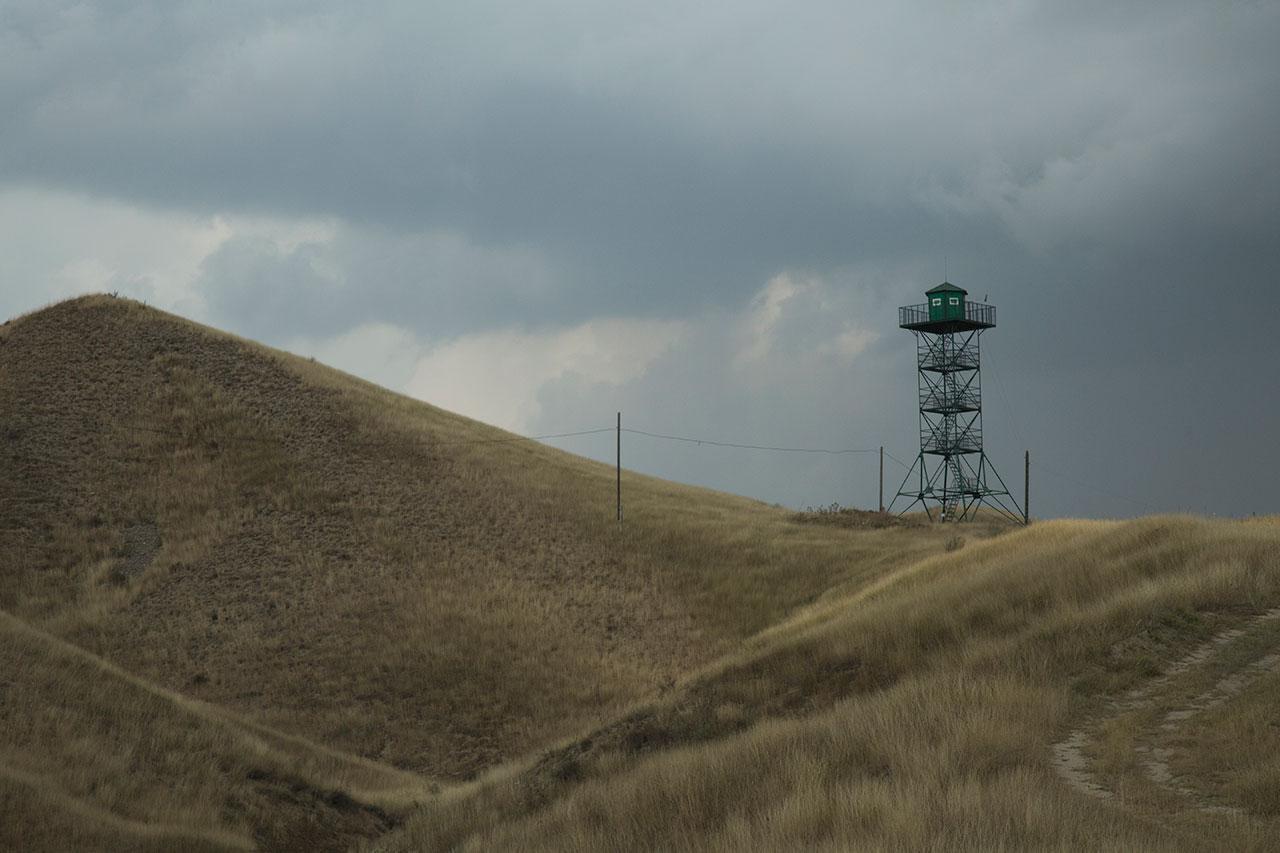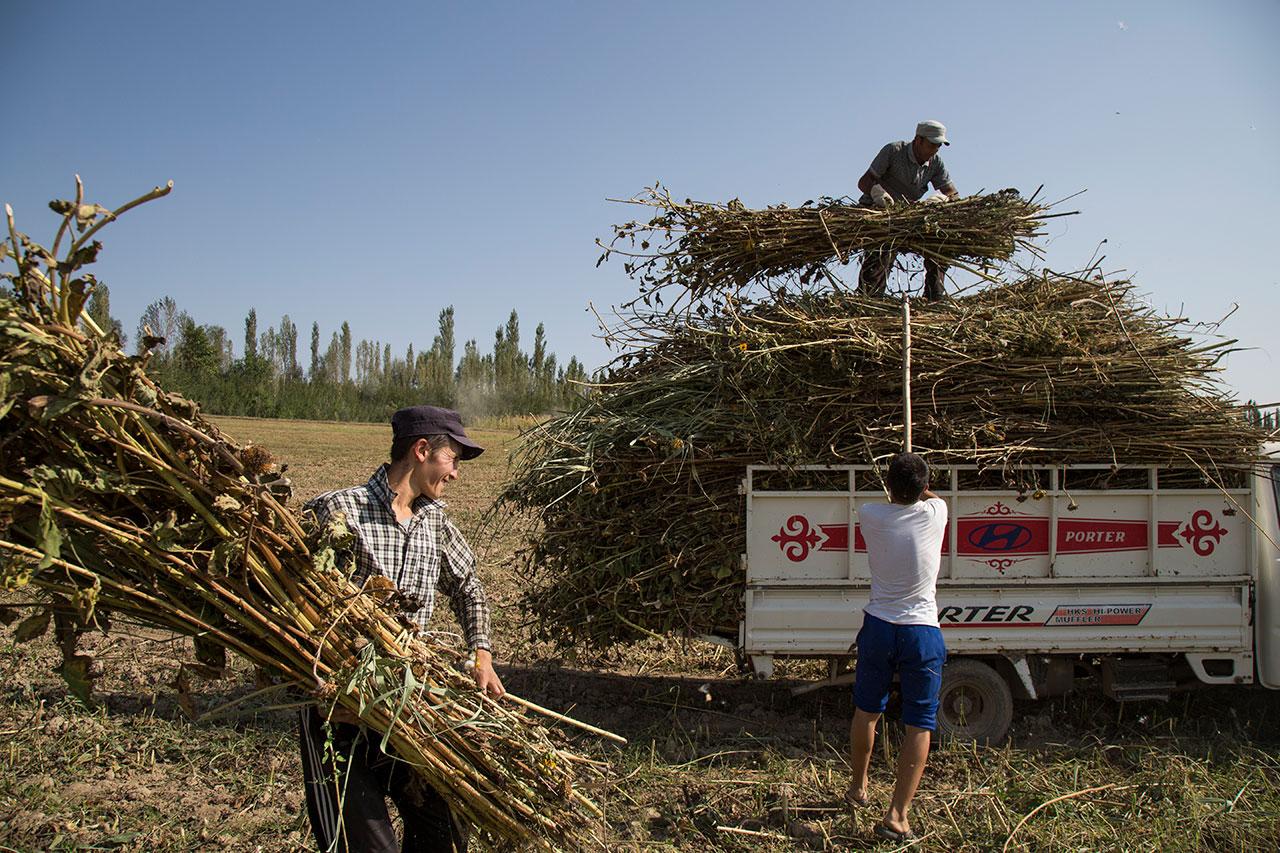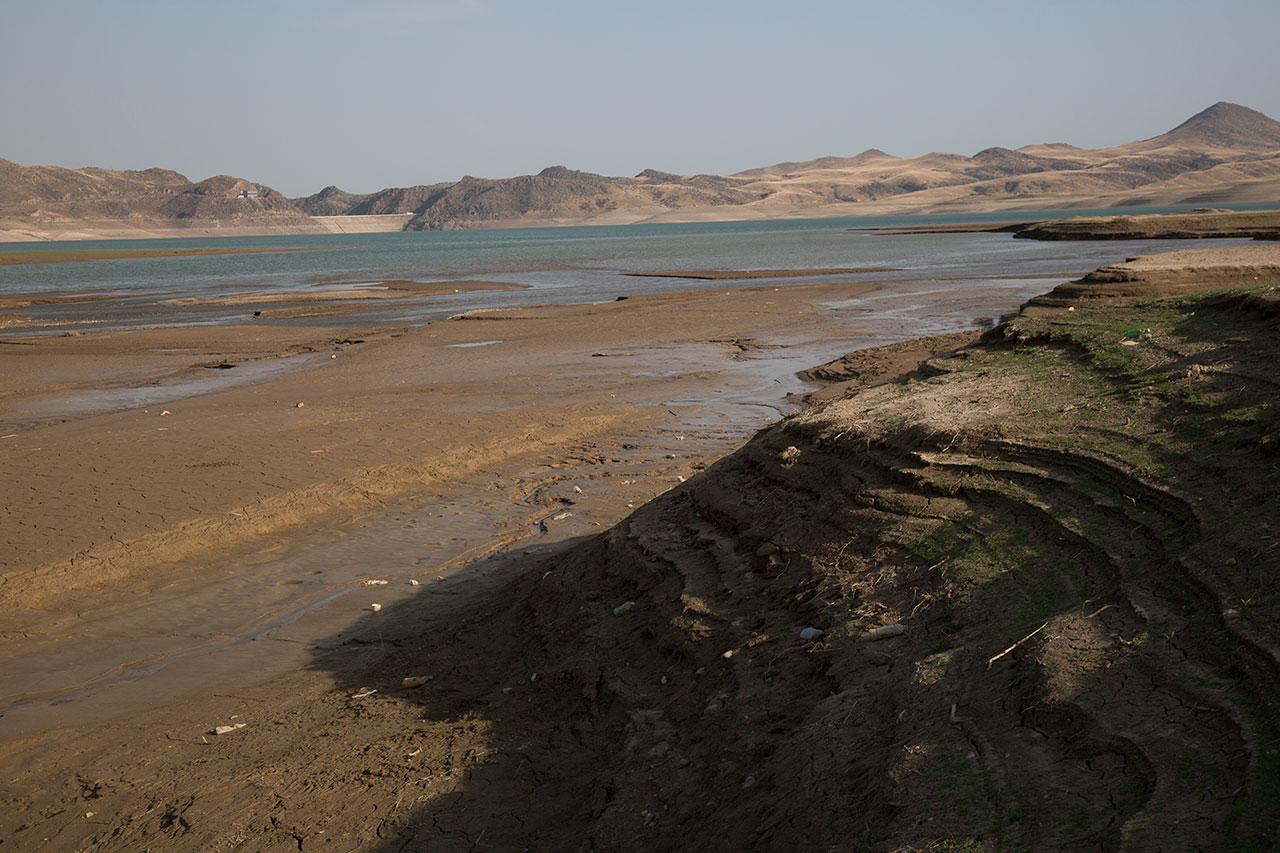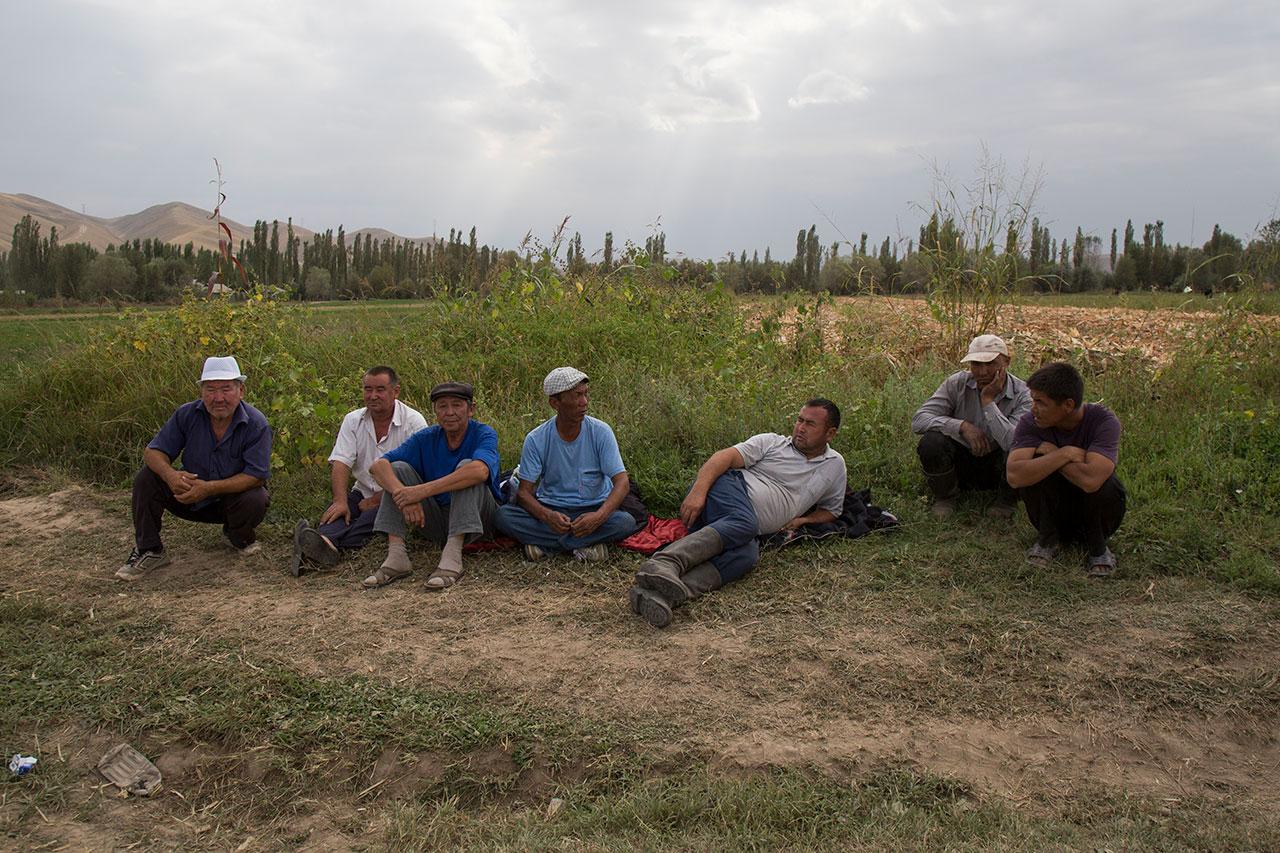The Kyrgyz soldier stepped quietly out of the dark green bushes and swung his Kalashnikov rifle in the direction of our car. Another emerged and did the same. Their checkpoint was a skinny log dragged across a broken asphalt road heading toward an ethnic Uzbek village and the disputed waters of the Kasan-sai, a reservoir that irrigates the agricultural heartland of the ancient Fergana Valley. With a sleepy shake of his head, the special forces sergeant waved his rifle and made us turn our beat-up Mitsubishi around. “There won’t be any fighting here,” the sergeant said.
At least not today. The quiet of the hot September afternoon was unbroken as we turned around and slowly ground off through the heat. Driving back the way we came through the parched foothills on the edge of the western Tian Shan range, a spur of the Himalayas, we did not pass any other cars.
[NB:slide]
But it has not always been this quiet. Throughout the spring and summer in 2016, tensions flared after ethnic Uzbek villagers and police blocked access to the reservoir and its water, which lies inside Kyrgyzstan. Uzbekistan drove armored personnel carriers into Kyrgyzstan, and both sides have captured and detained each other’s citizens. Fistfights and potshots have been common. For farmers scratching out a bare existence from increasingly dry land, water is lifeblood, and worth fighting for.
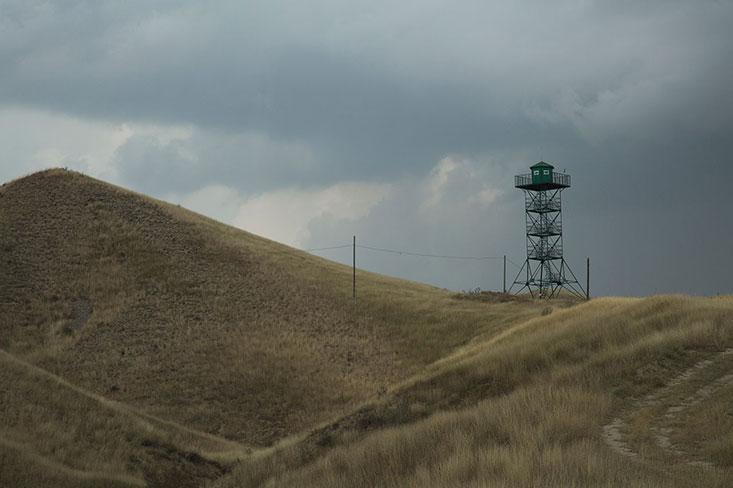
I have come to this remote and haphazard army post, standing between Uzbek and Kyrgyz farmers whose lands both need water, to see for myself the front line of climate change. A 2014 study in the Journal of Climate, published by the American Meteorological Society, reported that the warming rate in Central Asia has been twice the average global warming rate over the same period, and larger than any previous decade, over the first 12 years of the 21st century. As the region heats up, it faces increasing political instability and violence.
This is particularly so in the vast Fergana Valley. Its tangled knot of borders, ethnicities, water rights, decreasing resources, and increasing temperatures makes it a crucible of global warming and human conflict—a place where geography, climate, and politics collide. Indeed, historically violent ethnic divides and regular disputes over natural resources make armed conflict as a result of climate change more likely in this region, one that has already seen hundreds killed in two pogroms over the past 27 years, in part fueled by fights over territory and water.
“These small villages fight almost every day for water and land,” said an agricultural project manager for the U.S. State Department’s Agency for International Development (USAID) in Kyrgyzstan, who asked to remain unnamed. “As soon as something disrupts their agriculture, they have to fight or do something to ensure that they don’t go hungry in the winter.”
Down the road from the checkpoint, ethnic Uzbek farmers stacked dried sunflower stalks onto the bed of a dilapidated truck. They were too nervous about the armed standoff over the nearby reservoir to talk. They turned up the music in their truck and laughed nervously as they sweated in the dust and sun.
This has been the situation in this borderland since March, when Uzbek troops cut off the road to the town of Ala-Buka, near the reservoir. This move was sparked after Kyrgyz authorities denied an Uzbek request to repair the reservoir in Kyrgyz territory using Uzbek engineers. The security situation escalated from there and culminated in August with the seizure of a Kyrgyz communications relay tower on a disputed mountaintop by helicopter-borne Uzbek police, who detained a number of Kyrgyz technicians.
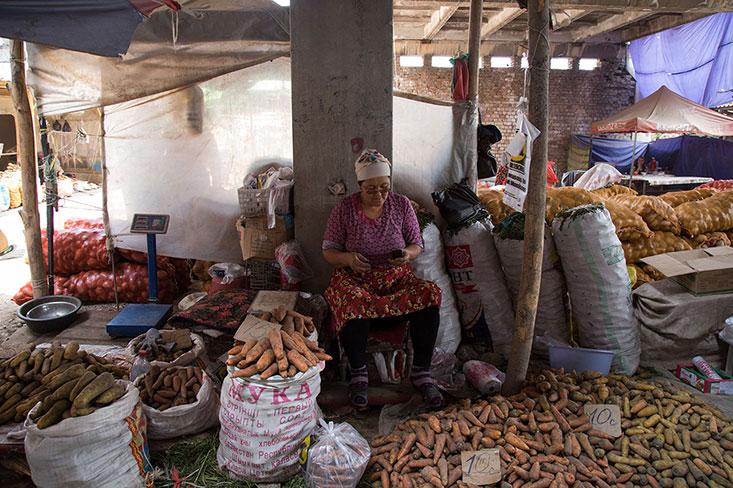
And there is reason to fight. The Fergana is the great cornucopia of fruit, vegetable, and cotton farms that once made up the agricultural heart of Central Asia. The wide basin was an oasis of food that built emirates, fed a blossoming of Sufi poetry, and was a stop in its own right on the ancient Silk Road. Today, the flatlands are covered in irrigated fields still famous for their melons, peppers, tomatoes, and strawberries. The Uzbek villages stand in the shade of innumerable poplars, fed on the water streaming out of Kyrgyzstan’s mountains. Sitting above this lush bowl, the rugged lands of Kyrgyzstan and Tajikistan are too mountainous for cultivation, supporting mostly livestock. They remain dry.
But this is all in flux. Climate change will continue to increase the area’s “environmental insecurity,” with the densely populated Fergana Valley being the most vulnerable, reads a 2014 report by the World Bank, which is funding economic research into how climate change will alter how people live around the world. Some 22 million people in the valley depend on irrigation for their livelihoods, and shortfalls in water—due to increased evaporation caused by higher temperatures and because glaciers are disappearing—are predicted to become a bigger problem.
Rasul Kasymov’s rice farm is representative of the region’s problems. To get to his smallholding farm in the village of Kyzyl-Sengir from the historic city of Osh, I drove 45 minutes through parched Kyrgyz countryside, past young boys herding bony cattle, and dusty communities of one-story homes. The Soviet-educated farmer greeted me and guided me down a road to his rice terraces on the floodplain of a river that flows into Uzbekistan.

Open irrigation ditches rushed with silted, blue water on either side of the dusty track and shady willows grew on their banks. Cows and horses drank from the muddy slopes as the water flowed into the surrounding fields. This bucolic scene is typical of the rural Fergana Valley, but the pleasant surroundings obscure the environmental problems.
“We keep telling these guys about climate change,” the USAID agricultural specialist, said. “There are some good farmers who understand they need to worry about it, but they do nothing.” Because their plots are small, most farmers in the Fergana do not have the money to invest in new equipment or infrastructure, and they are not trained in water conservation.
It’s a hand-to-mouth existence. Much of the water in the canals along this path evaporates, and when it does reach a field, it leaches minerals and salt out of the soil. At the same time, livestock is allowed to overgraze, making the poor earth more susceptible to desertification and erosion caused by flash floods.
We dropped down a short dirt slope to Kasymov’s rice paddies above the river. The irrigation water in the ditch formed a small waterfall. The cool sound of the water splashing into a grassy pool was in contrast to the heat of the day. Below this, the water overflowed and flooded the path in wasteful abundance before running back into the village’s rice fields. The old farmer walked out onto an earthen berm and pulled up a handful of the reddish colored rice for which this area is famous.
“Before there was a lot of water, but now it seems to me that water is becoming less everywhere,” Kasymov said. “The glaciers are melting.” He waved a sheaf of rice at the mountains upstream. “We are dependent on the water here. Without this water no one would live here.” When I asked if there were ever fights over water between farmers he answered, “No. There are no conflicts here. We don’t have any Uzbeks.”
In the Fergana Valley, ethnicity is a volatile issue. Kyrgyzstan and Tajikistan both have significant ethnic Uzbek minorities of around 14 percent. Layered on top of this is a population exploding across a landscape with limited farmland. Since 2000, the population of the five former Soviet republics in Central Asia has grown by almost 10 million, and this is expected to grow to 95 million by 2050. Of the 65 million people currently living in the region, around 5 million lack reliable access to food.
Climate change represents an enormous challenge to these growing populations. If temperatures continue to climb at their current rate, the World Bank predicts a 10 to 15 percent drop in the water levels of the Amu Darya, one of Central Asia’s great rivers, by the 2040s, and a 10.7 percent drop in the GDP of the region.

Besides ethnicity, evaporation, misuse, population, and poverty, the issue of water is further complicated by the borders in the region. Before the Soviet Union’s breakup, water ran through a united country. Now the water courses through independent countries, crossing disputed borders. Kyrgyzstan and Tajikistan control most of the sources, while Uzbekistan, Kazakhstan, and Turkmenistan have to either accept what their upstream neighbors give them, pay, negotiate, or try to take it.
What’s more, bubbles of independent ethnic territory exist within Kyrgyzstan and Uzbekistan, where ethnic villages have been cut off from their home countries. Water sometimes crosses three or four borders in just as many miles. The confusing map has caused fights to break out between neighboring farmers.
These altercations, which often lead to the police or military having to be called, inflame preexisting ethnic tensions. Kyrgyz farmers “hate” Tajik farmers, while Tajiks say the Kyrgyz block water, keeping it from flowing downstream. When the water stops flowing, said the USAID agricultural specialist, the first thought many farmers have about their counterparts across the border is, “We should kill them.” Politicians have used the disagreements over natural resources to stoke ethnic tensions. These exploded once in Kyrgyzstan in 1990 and again in 2010—incidents in which hundreds, if not thousands, of ethnic Uzbeks were killed and tens of thousands were displaced.
One afternoon in Ala-Buka, Akim Orozov, a thick-set, retired policeman, commanded Ala-Buka’s livestock market with an unbelievably loud voice, brokering rough-and-tumble trades with a crushing handshake under the shade of the lot’s lone tree. “The reservoir is ours,” he told me. “It is an important strategic object. We will not give it up.” Like everyone in the area, he understands water intimately. “If [the Uzbeks] don’t have water, they’ll have a drought,” he said. “If there is a war, we will stand with dignity. Let them come.”
Conflicts over natural resources are not new, but as climate change shrinks access to water, their occurrence is bound to rise worldwide. From 1980 to 2010, almost a quarter of all armed conflicts in ethnically divided countries coincided with climate-related natural disasters, reported the Potsdam Institute for Climate Impact Research, in a study published in the Proceedings of the National Academy of Sciences. The risk of violence was “exacerbated by anthropogenic climate change and in particular climate-related natural disasters,” the report said, adding that Central Asia is “exceptionally vulnerable to anthropogenic climate change and characterized by deep ethnic divides.”
The analysis noted similar linkages between climate-related natural disasters, ethnic divides, and armed conflict outbreak in Syria, Somalia, and Afghanistan over the past 30 years, citing the “societal consequences” of drought. “We’re not saying there’s a climate disaster and this will cause a conflict, but in the context where it will basically add to societal stress, then this could enhance the risk for the outbreak of conflict,” said lead researcher Carl-Friedrich Schleussner.

Around 10 percent of Central Asia’s population has already been hit by natural disasters since the 1990s. These include mudflows, landslides, heat waves, drought, desertification, earthquakes, torrential rains, and spreading malaria.
In 2015, half a village was destroyed in the mountains of neighboring Tajikistan when a multistory wall of water blasted out of a slot canyon, caused by either torrential rains or a glacial lake bursting its dam upstream. To put this in context, scientists report that more than 2,000 glacial lakes cover Kyrgyzstan. Of these, almost 20 percent pose a hazard of “outburst” and 12 are considered “actually dangerous.” This sounds like a small number, but around 300,000 cubic meters of water sits in dangerously unstable glacial lakes above the Kyrgyz capital of Bishkek, with a population of around 1 million people. Since 1952, more than 70 “disastrous” cases of lake outbursts have occurred across Kyrgyzstan. These numbers put Bishkek in the crosshairs and illustrate the risks posed by a litany of environmental disasters.
The cowboy whistled piercingly and Barsik, his 140-pound sheepdog, shot over the rolling green humps of the high mountain valley, and chased an errant bull back into the herd. High on the mountainside, Nurdin Orozaliev’s flock of around 500 sheep streamed through the well trimmed grasses of late summer.
The 15,000-foot peak of Chok-Tal was just catching the first rays of the early morning sun, washing the blue monochrome of dawn out of the valley. Nurdin, 52, sprang into his saddle and trotted into the snorting confusion of cattle, guiding them to their pasture for the day.
This is the Kyrgyz high country. In summer, shepherds from across the nation flock to the Chon-Kemin, a 2-mile high, 75-mile long valley in the north. Every summer they bring their livestock here to fatten up on the lush grasses. Nurdin’s morning chores done, he rode ahead toward the loose rock moraines and glacier on the flanks of Chok-Tal.

The Dzhindi-suu, or Crazy Water River, rushed past on the floor of the ravine. This will be their last year at this camp. “The wind coming off the glacier is too cold. My sheep and cattle haven’t fattened up as much as they would have in another side valley,” Nurdin said. But with glaciers disappearing, his grandsons might be able to return here in a couple decades.
“Before, the glacier was visible [from our valley] and now it is not,” said Nurdin, approaching the end of the grass and the start of the rock. The feeder streams of the Crazy Water poured out of the face of the glacier 1,000 feet above us and cascaded down through the boulder field. Jumping from rock to rock, he headed up the mountain. “The glacier is melting. I don’t know how it will be for us in 20 or 25 years,” he said. “It’s a tragedy. It will have a bad effect.”
After more than an hour of climbing through the steep rubble of pink and gray granite boulders, the rocky tongue of the glacier came into view. Sheer planes of dirty ice stepped almost vertically into the sky. Nurdin climbed under an overhang and drank water melting off the curved lip. He grabbed a rock and hacked off a chunk of ice. He held it up to the sun and the piece of glacier lit up, light refracting off the ancient air bubbles locked in the shard.
“The signs are very clear. Almost all glaciers in Central Asia are losing mass,” said Annina Sorg, a Swiss scientist who has made multiple trips to the Chon-Kemin valley to research its glaciers. A study by Sorg and others of the Tian Shan range found annual glacier area losses of 0.36 to 0.76 percent, “causing concern about future water security.” Even in cooler, wetter conditions, glaciers will lose up to two-thirds of their 1955 extent by the end of the 21st century, while in warmer scenarios, they are expected to “disappear completely” by around 2080.

Right now, though, the melt is having a somewhat positive effect, since melting glaciers provide a steady supply of water. But Sorg’s research has shown that “peak water” could be reached by the 2020s. And, regardless of any way the climate could change, “the days of plenty will not last much longer, as summer runoff is projected to decrease.”
Sorg worries how the coming water shortages will be handled across unstable borders between countries and ethnic groups that already distrust one another. “I’m more scared that climate change will lead to war and to political conflicts,” she said. “I would be more afraid of people than of nature.”
Some see an opportunity for action. André Fabian, a project manager in Central Asia with GIZ, a German development agency, believes climate change might ironically offer a solution. The battle over water has made neighboring countries into enemies. “There are the upstream countries, there are downstream countries, and they blame each other for whatever reason,” he said. But the countries have a common enemy in climate change. “They come, and we can talk sometimes, even about the same topics, but under the umbrella of climate change.”
But it is unclear what that means for actual farmers, cowboys, and everyone else in the region—both in parched upstream countries like Kyrgyzstan, and in wet, downstream countries like Uzbekistan. Driving slowly out of Ala-Buka, our Mitsubishi weaved through the overflowing Saturday market between old, mustachioed men carrying giant yellow melons and women in headscarves pulling along young children.
After a 20-minute drive through the dry hills, we reached the grassy edge of the reservoir. Satinbay Mamashev herded his cattle and shouted when some wandered into a burdock thicket. “If I had water, I’d live like a king here,” said the 73-year-old through his long whiskers. “Where they have water, that’s Uzbek agriculture. Where there is no water, that’s my land.” He pointed his shepherd’s stick toward the green of the Fergana Valley. “Without water, it is impossible to live.”
Above us, on a rocky escarpment overlooking the disputed reservoir, stood a Kyrgyz armored vehicle with its guns pointing toward the Uzbek village.
John Wendle is an independent writer, photographer, and videographer based in Kiev, Ukraine. You can view more of his work at www.johnwendle.com and on Instagram.


























